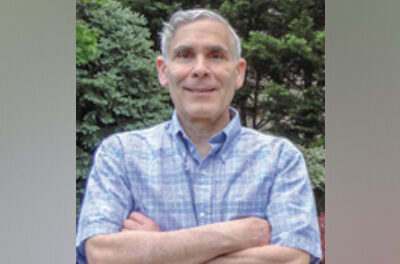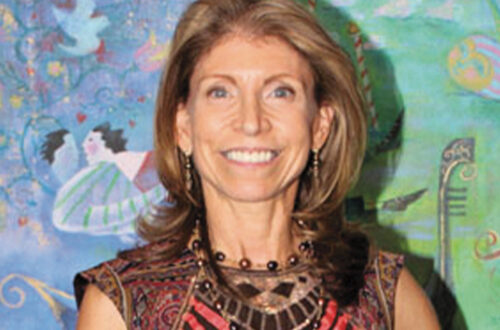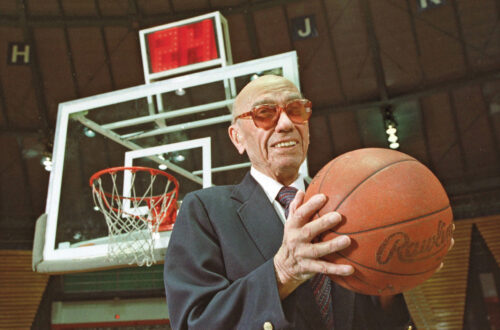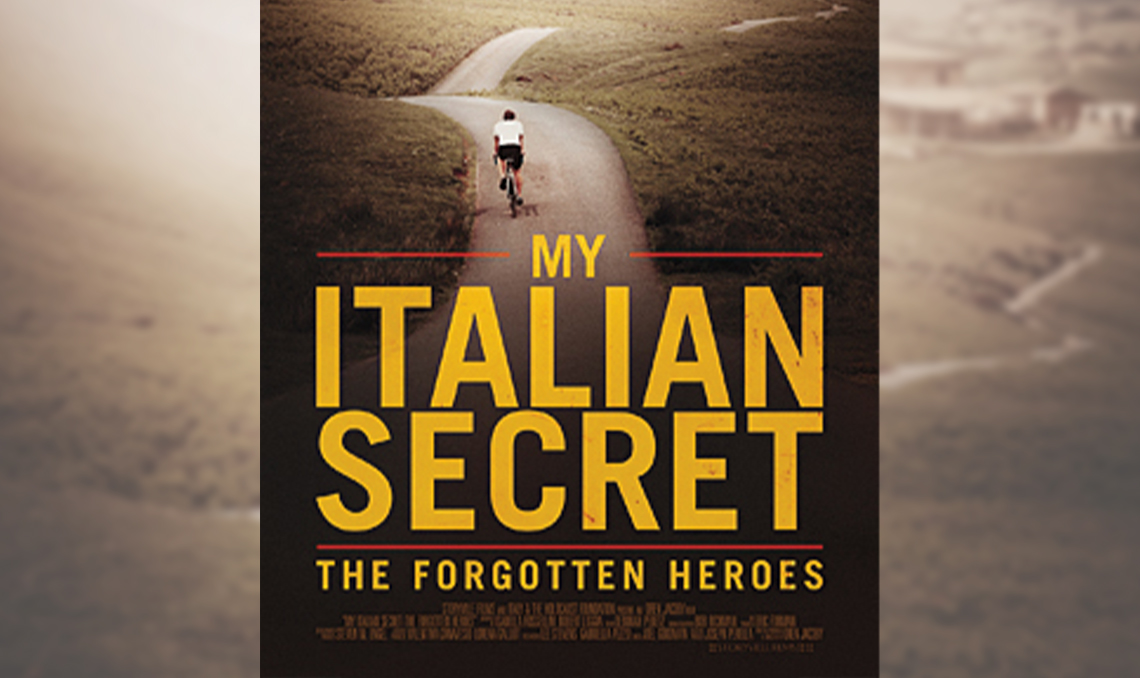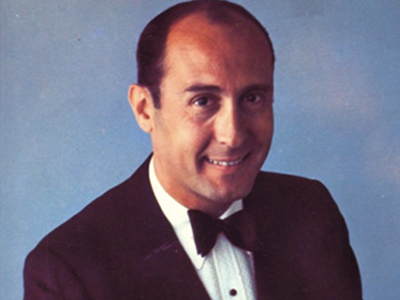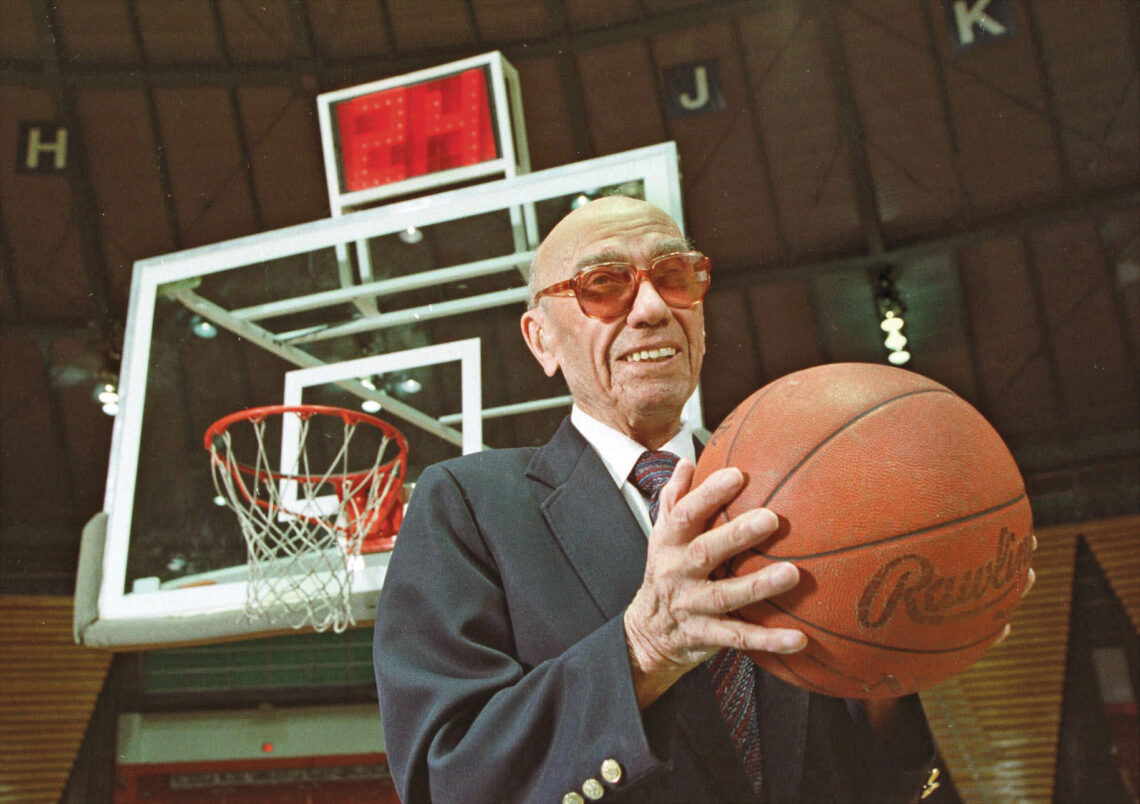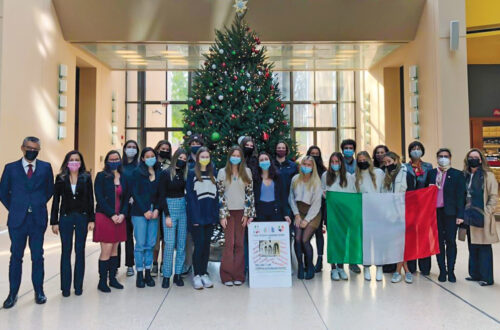-
Festa di San Giuseppe and its Famous Zeppole Pastries
By Cathy Branciaroli

Light and airy Zeppole made with ricotta cheese are the highlight of foods celebrating the Festa di San Giuseppe.
Photo courtesy of Little Italy San DiegoIn Italy, Father’s Day is celebrated on the Festa di San Giuseppe which honors St. Joseph, the earthly father of Jesus. And, such a celebration it is. On March 19, the day of the feast, street processions are held with marchers dressed in red, special church services are conducted, elaborate displays laden with traditional foods are assembled and community spirit fills the air.
St. Joseph is the patron saint of many things including woodworkers, family life and pastry chefs. On this special day, prayers are said for his intercession in things great and small. The celebration of this feast began as one of thanks by the people of Sicily, which was experiencing a terrible drought and famine in the 1800’s. In an act of desperation, villagers prayed to St. Joseph for relief and when it came, they began the tradition of honoring him and giving thanks to others in gratitude for what they now had. The tradition soon spread to many parts of Italy including Abruzzo and Molise where it has been strongly embraced. In the U.S., this also is a special Italian feast, carried to this country by immigrants. Today it thrives in cities with large Italian communities such as Baltimore, Buffalo, San Diego and New Orleans.
Key to the feast is food, particularly the tradition called St .Joseph’s Table and its accompanying sweets, including Zeppole pastries. AMHS member and filmmaker Kirsten Keppel created a documentary focusing on this subject in 2017, which has been recognized with a number of awards. In it, parishioners from Baltimore’s Saint Leo the Great Church describe the Table’s religious, cultural and culinary aspects as well as the making of the famous Zeppole pastries. The 18-minute video is available at this link: vimeo.com/231190592.
Thirteen dishes, mostly simple ones, typically make up the Table’s fare, all of them meatless since the feast falls during Lent. The devotional fare symbolizes the plenty that followed the Sicilian famine, and its abundance is offered in hopes for future good fortune. The table is lush with oranges and lemons, overflowing with fava beans and fragrant with flowers. The meal is capped with bucatini pasta, usually con sarde e finnochio. This is sprinkled with bread crumbs, the poor man’s parmesan cheese, mimicking the sawdust of Joseph the carpenter. Bread is also distributed to friends, relatives and people in need. Finally, the sweets are presented including the Zeppole which also are called sfinge. Traditionally Zeppole only are prepared at the time of this feast. Resembling a doughnut in shape, size and texture, the dough typically is piped, fried, filled with a ricotta cream and topped with a dusting of confectioner sugar. Of course, the foods are liberally accompanied by glasses of red wine.
For those who would rather forego recreating the entire Table of foods, it’s possible to prepare just the Zeppole pastries. In support of such efforts, here is a recipe for making them, provided by PBS chef Lidia Bastianich.
Zeppole di San Giuseppe Ingredients for the Filling:
3 cups ricotta
½ cup confectioners’ sugar
1/4 cup finely diced candied orange peel
1/4 cup finely diced candied lemon peel
1/4 cup small chocolate chips or bittersweet chocolate chopped in small pieces (optional)
Ingredients for the Zeppole Dough:
1 cup water
4 tablespoons unsalted butter
1 tablespoon sugar
½ teaspoon salt
1 cup unbleached flour
4 large eggs
1 teaspoon grated orange zest
1 teaspoon grated lemon zest
6 cups vegetable oil (if frying the zeppole)
Confectioners’ sugar and Amarena cherries in syrup if desiredPreparation
Combine the ricotta and ½ cup confectioners’ sugar in a food processor. Process until creamy. Add a little Grand Marnier and process until incorporated. Scrape the ricotta mixture into a bowl and stir in the candied fruits and chocolate chips. Store covered in the refrigerator until needed, up to 2 days.
In a large, heavy saucepan, bring the water, butter, sugar and salt to a boil. Add the flour all at once, and beat vigorously with a wooden spoon over medium heat until the dough leaves the sides of the pan and forms a ball around the spoon. Remove from heat and quickly beat in 1 egg at a time, beating until batter is smooth after each addition. Add the orange and lemon zest and continue beating until mixture is smooth and glossy.
For the fried version: In a heavy, 3-quart pot, heat the vegetable oil until a deep-frying thermometer registers 350° F. Higher temperature will cause the dough to brown before the center is fully cooked. Carefully drop rounded tablespoonfuls of the batter into the oil, about 6 at a time. (There should be enough room in the pot for the zeppole to float freely.) Fry, turning the zeppole as necessary, until golden brown on all sides, about 6 minutes. Adjust the heat under the pot to maintain the temperature of the oil as the zeppole fry. Remove with a skimmer and drain on paper towels. Repeat with the remaining batter allowing the oil to return to 350° F before continuing.
For the baked version: Preheat the oven to 425° F. Drop the batter by rounded tablespoonfuls onto a lightly greased or non-stick baking pan. Bake until evenly and lightly golden brown, about 20 minutes. Reduce the oven temperature to 350 degrees F and continue baking until medium golden brown and a Zeppole feels very light when picked up from the baking sheet, about 15 minutes. Transfer to a rack and cool.
Cut the Zeppole in half, leaving it attached on one side. Spoon the filling into the zeppole, dividing evenly. Dust the tops of the Zeppole with remaining confectioners’ sugar and one or two Amarena cherries in syrup. Serve at room temperature or chilled.
Note from Lidia: She prefers the ricotta to simple pastry cream as being more authentic, tasting milkier and feeling more home made. But, as Lidia says, she just loves ricotta.(Cathy Branciaroli is a Delaware-based, award-winning food writer and a member of the AMHS. Her website, Delaware Girl Eats, has been honored nationally for its enticing posts and its narratives about the stories behind the dishes being featured.)
March/April 2022
-
A Message from the President
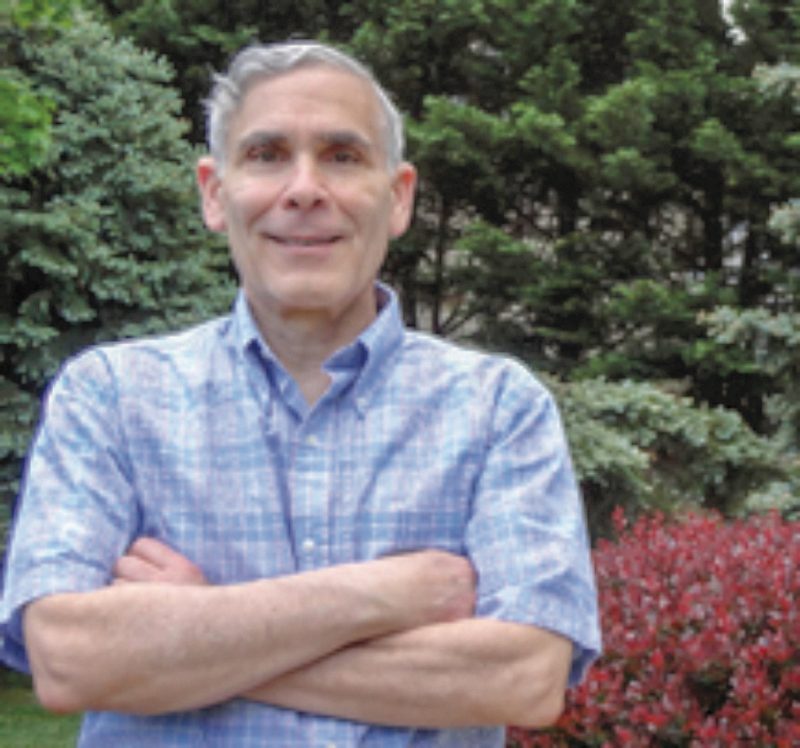
Dear members and friends:
Spring is on the way! It may or may not bring baseball, but it is coming just the same. It remains the season of new beginnings, ushering in many natural delights for us to enjoy.
When spring does get here, it will unfortunately meet up with the Omicron variant of COVID-19, which will likely still be causing problems. The resurgence of Omicron cases in December and January prompted the AMHS to postpone its planned first program of the New Year. The program was to have been an in-person event in which Eric Denker, the Senior Lecturer at the National Gallery of Art, was to be the guest speaker. Our consolation though is that we can continue to look forward to his presentation on Venice, as we will present Mr. Denker at an in-person event later this year. In place of our postponed event, we held a virtual discussion of the documentary film “My Italian Secret: The Forgotten Heroes”, which recounted the bravery of many Italians who put their own families at risk in saving the lives of thousands of Jews, partisans and refugees during the Holocaust. Jim Toscano, who is himself a filmmaker, led the discussion and offered numerous insights into both the content and the techniques used in the film. The timing of our event was purposeful, as it took place just three days after International Holocaust Remembrance Day. Participants in the excellent discussion of this outstanding film included Italian Americans joining us from coast to coast — from Los Angeles to Pittsburgh, which is one of the great advantages offered by virtual events and made possible by today’s technology.
By the time you read this, we will have offered another interesting event in the remote format. On February 27, we presented “Italian Louisiana: History, Heritage, Tradition”, a virtual talk by historian and author Alan Gauthreaux. Mr. Gauthreaux discussed the history of Italians in New Orleans, explaining the many ways in which these immigrants shaped the culture of the city. It is a fascinating topic, and I hope that you were able to enjoy it. Please stay tuned for additional upcoming events because our Program Committee has enlisted a number of excellent speakers who will talk on topics of interest to just about everyone.
Speaking of topics of interest, do not miss Nancy DeSanti’s piece later in this edition. It describes the kind of adventure that we usually only see in the movies or in travelogues. AMHS member Willy Meaux has made a life-changing decision to return to his ancestral roots in Abruzzo. He and his wife purchased a farmhouse and surrounding land, on which they plan to establish a vineyard. Check out this exciting endeavor inside this Notiziario and then dream along with the rest of us.
I would like to thank the many members who have contributed to our Annual Scholarship Fund. To date, we have received $9,415, which not only breaks last year’s record-breaking amount but also represents the largest sum of monies raised in the history of our scholarship appeals. Your generosity is a clear indication of the value you place on our Scholarship Program, which may very well be the most important undertaking in our mission to preserve and promote our shared heritage and to pass along an appreciation for it to future generations. Our campaign continues, so it is still not too late to make a contribution if you would like to be a part of this record-setting success.
Regarding our scholarship program, I am pleased to announce that the AMHS has received a generous donation to start an additional and separate scholarship fund. The fund will select winners from applicants who are majoring in music. It will be named for Angela Lastrico Raish, a longtime friend of several AMHS members. Please be on the lookout for additional details on this exciting expansion of our scholarship program.
In the meantime, enjoy the spring. I am looking forward to it, and I am also looking forward to seeing you at one of our future events — whether in person or virtual.
Best regards,
Ray LaVerghettaMarch/April 2022
-
AMHS Holds Discussion of Italy’s “Forgotten Heroes” of the Holocaust
By Nancy DeSanti, 1st Vice President-Programs
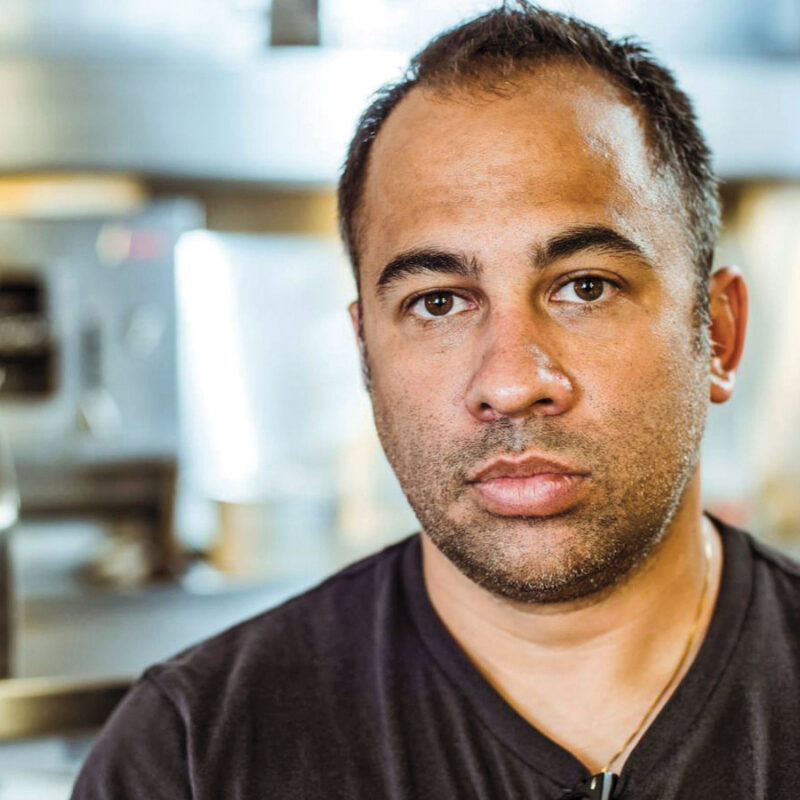
Jim Toscano
Credit: Courtesy of Jim ToscanoOn January 30, 2022, the AMHS held a virtual discussion of the documentary film “My Italian Secret: The Forgotten Heroes,” led by Detroit-based documentary filmmaker and Society member Jim Toscano.
The film was selected for discussion to commemorate International Holocaust Remembrance Day on January 27, 2022, marking the 77th anniversary of the liberation of the Auschwitz-Birkenau concentration camps in Poland, where 1 million of the 6 million Jews perished during the Holocaust.
To realize how this is relevant in today world, it was reported that the day after Holocaust Remembrance Day, just a few blocks from Casa Italiana at Union Station, a man was arrested for spray-painting Nazi swastikas on the station’s walls.
And not long ago, in 2020, a survey was taken by a group of educators and historians, interviewing Americans 39 years old and under (millennials and Gen Z) all across the country. This survey found that 63 percent of these young Americans did not know that 6 million Jews perished in the Holocaust and, shockingly, 11 percent thought that the Holocaust didn’t happen or that it was caused by the Jews.
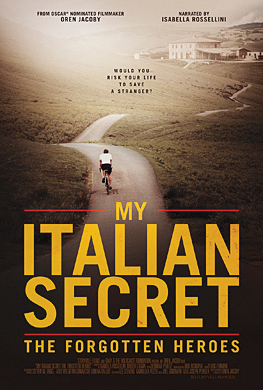
So maybe that’s why this year there have been a number of commemorative events in our area. On January 24, 2022, the Italian Cultural Institute and the Embassy of Italy hosted a webinar live-streamed from Italy with Auschwitz survivor Edith Bruck, an author who lives in Rome and who gives talks in schools all over Italy. One of her books included a “Letter to God” which drew the attention of Pope Francis, who made a two-hour visit to her apartment last year.
And the U.S. Capitol Historical Society hosted a webinar, now available on their website, with a lecture by Dr. Peter Hayes, a leading Holocaust expert. He addressed the questions of how and why did it happen? Why did no one stop it? And how is this relevant today? His answers were interesting — and also chilling.
The documentary discussed by our AMHS members and guests was sponsored by the Italy and the Holocaust Foundation. The film, narrated by Isabella Rossellini, tells the story of the famous cyclist Gino Bartali, who came from a poor Tuscan family of devout Catholics. After winning the Giro d’Italia and Tour de France in the late 1930s and becoming famous all over Europe, he was married in 1940 by the Cardinal of Florence, who would later recruit Bartali into a secret network that delivered forged identity papers to Jews hiding from the Nazis and Fascists. The film includes an interview with Bartali’s son and a member of the Jewish family who hid in the basement of Bartali’s home. “Good is something you do, not something you talk about,” Bartali famously said. “Some medals hang on the soul, not on the jacket.”
“Good is something you do, not something you talk about.”
– Gino BartaliThe film poses the profound question: “Would you risk your life to save a stranger?”
One of everyone’s most memorable characters was the 107-year-old elegantly dressed man in a wheelchair, interviewed in the piazza of his small town, who still vividly remembered how his town had all come together to hide the Jews, at the risk of their own lives. This “conspiracy of silence” took place in small towns across Italy, and the film shows many moving scenes of survivors returning to thank the children and grandchildren of the people who helped save them.
Lynn Sorbara, whose father served in the Army in World War II in Europe,remembers him telling her about the Ferramonti internment camp in Calabria run by the Italians, where prisoners were treated more humanely than in camps run by the Germans. In the film, one of the survivors returns to the camp and remembers being there as a child with her parents and then, in an emotional moment, she spots their photo on the wall.
Peter Bell asked about the use of re-enactments in the film, and Jim gave us some interesting insights into the pros and cons.
Carmine Spellane and several people remarked that, while the controversial role of Pope Pius XII is more widely known, they did not realize how much the priests and nuns did to help save the Jews, refugees and partisans during the war. Assisi was especially mentioned as a place where, in the spirit of St. Francis, Gino Bartali would deliver the forged identity papers to the convents and monasteries. The film shows many instances of tolerance and respect for one’s fellow man, even in a small way.
Many thanks to the Italy and the Holocaust Foundation for sponsoring the making of such an important and relevant film (available on Amazon Prime and Apple TV). And many thanks to Chris Renneker for organizing the event and to Jim Toscano for leading us in such an interesting discussion.
March/April 2022
-
AMHS Member Willy Meaux Returns to His Roots in Abruzzo
By Nancy DeSanti with Willy Meaux
AMHS member Willy Meaux recently took the plunge and bought a farmhouse and surrounding land in Abruzzo, in his ancestral hometown, Bugnara. It seems Willy and his wife Mary Bernard chose well, since a few years ago, the town was named one of the most beautiful in Italy (i borghi più belli d’Italia).
In December 2019, just before the COVID pandemic hit, Willy made his offer on the farmhouse and land. He said what motivated him to act was a presentation at the Italian Embassy encouraging investment in Italy, especially in cities with a population under 20,000.
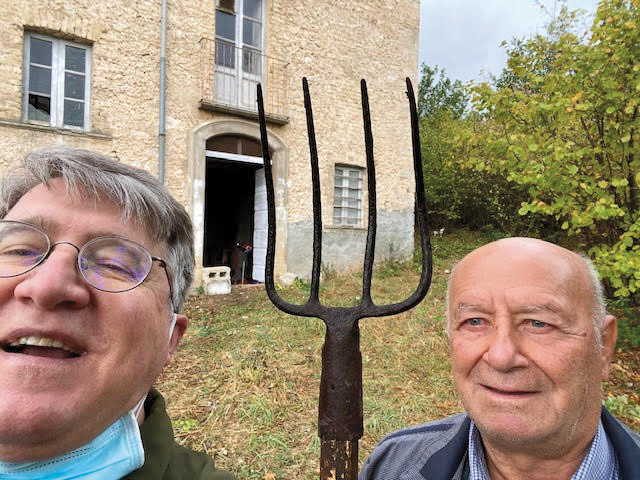
Willy Meaux (left) takes a selfie with his cousin Franco in front of his farmhouse.
Credit: Courtesy of Willy MeauxAnd now Willy and Mary are the proud owners of a casale (farmhouse) and farm in Bugnara, in the province of L’Aquila, located just a few kilometers up the mountains from Sulmona. They enjoy harvesting hazelnuts, olives for oil, and working with family members who have wine grapes. Eventually, Willy plans to establish his own vineyard on his land. He also enjoys hunting for truffles that are found in abundance among the oak trees on his farm. Willy credits his grandfather with inspiring him to “come home” to Bugnara, a place he has been visiting since he was 8 years old.
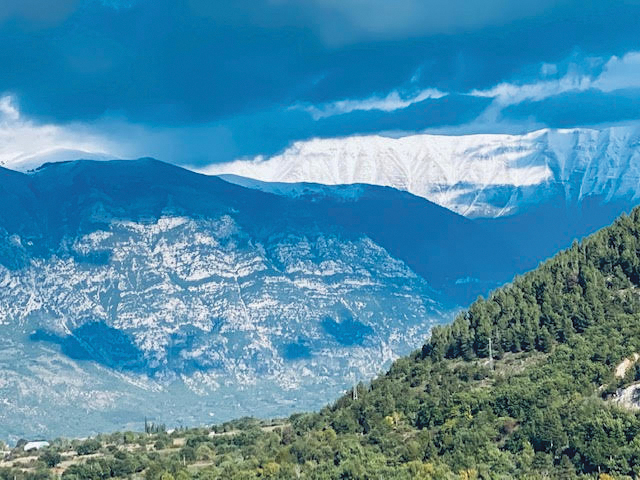
A view of the Gran Sasso d’Italia from Willy’s and Mary’s front door.
Credit: Courtesy of Willy MeauxHe found that it was quite hard to navigate the bureaucracy in Italy, but with the help of an excellent attorney, he got it done without even being in the country for most of the preparations and the final transaction. He said the main impact COVID had was in slowing everything down, so it took 15 months from the time of his original offer to complete the transaction.
Willy, who was president of the Vespa Club in Washington, D.C., said he will definitely buy a Vespa as his very first vehicle purchase. He said he loves riding a Vespa in this beautiful area, which has the National Park of the Maiella very close to his house, and the National Park of the Gran Sasso just beyond. He said Mary has plans to buy a good 4-wheel-drive car that can manage the very mountainous area. He also wants to buy a tractor for his farm.
Willy said he and his wife really enjoy the excellent cultural and agricultural events sponsored by Bugnara. The natural beauty of the area is its greatest wealth, he said, but the town is also rich in cultural assets. For example, it hosts a major flower festival known throughout the region. For olive producers and grape growers, there are excellent presentations with some of the best agricultural experts assigned to the region of Abruzzo. All the farmers gather for these special presentations, he noted.
And he said the city has a wonderful museum where, for example, a donkey-driven olive press built in 1898 was rebuilt to its original condition as an exhibit. He said his grandfather Donato Iandimarino would have been one year old when this olive press was built, and no doubt as a young man helped his father deliver his olives to be pressed by that very machine.
His grandfather immigrated to the United States in 1914, following in the footsteps of his brother Antonio. Willy’s grandfather married Algera Martinelli Iandimarino whose family is originally from Lettopalena, a village in the province of Chieti not far from Bugnara, located on the other side of the Maiella mountain in Abruzzo.
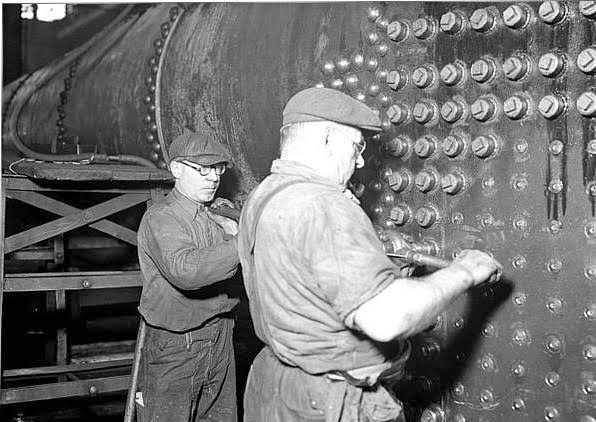
A vintage shot of Willy’s grandfather, Donato Iandimarino (foreground) working on the Pennsylvania Railroad.
Credit: National ArchivesWilly said he realized during his first trip to Bugnara at the age of 8 that his grandfather’s spirit was ever present in Bugnara, and that his grandfather had never really left, even though he spent most of his life in America. To Willy, his grandfather, a boilermaker for the Pennsylvania Railroad, was an inspirational man and a true farmer in his heart.
Asked how hard it was to deal with the building and restoration project on his property, Willy commented: “Rebuilding a house and restoring farmland is nothing compared to the incredible challenge my Italian ancestors experienced to come to America. The Italian immigrants to America were the boldest, strongest, the youngest, the most courageous, and they built America in the last century. I only hope I can make as much of a contribution to Bugnara as my grandfather made to America.”
It’s not just a farmhouse he is restoring; Willy said — he is building a bridge for his entire family to come home to Bugnara, to Italy. The beautiful Adriatic Sea and Pescara are less than an hour away, he noted. He said Mary loves going to the open market in Sulmona in Piazza Garibaldi, just a few kilometers down the mountain. And Willy said he and his wife get to go to the Chiesa della Madonna della Neve in Bugnara — the church where they were married in 1987.
For a related article on Bugnara in this Notiziario, see “Bugnara: Province of L’Aquila, Region of Abruzzo.”
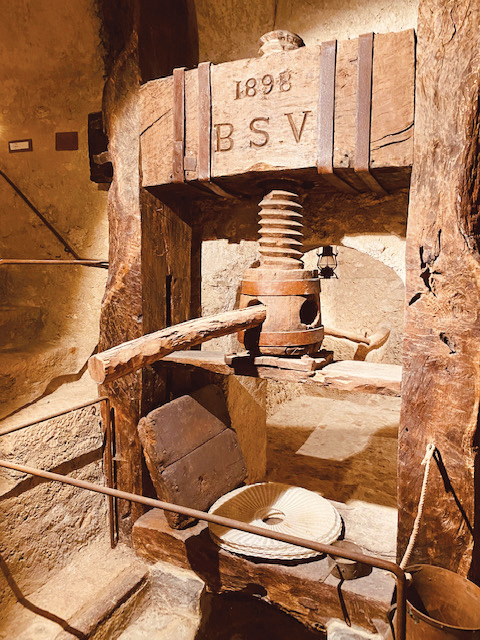
The donkey-powered olive press which Willy’s family once used, now in the local museum.
Credit: Courtesy of Willy MeauxMarch/April 2022
-
Danny Biasone: Inventor of Basketball’s Shot Clock
By Joseph “Sonny” Scafetta, Jr.
If you like the fast paced action of basketball, give thanks to an immigrant to America from Abruzzo.
Dante Biasone was born in the town of Miglianico (population 4,529 in the 2004 Census) in the province of Chieti in the region of Abruzzo, on February 22, 1909. When he was 10, he immigrated with his parents and his brother to Syracuse, New York. When they became U.S. citizens, he changed his name to Daniel, so his friends called him “Danny”.
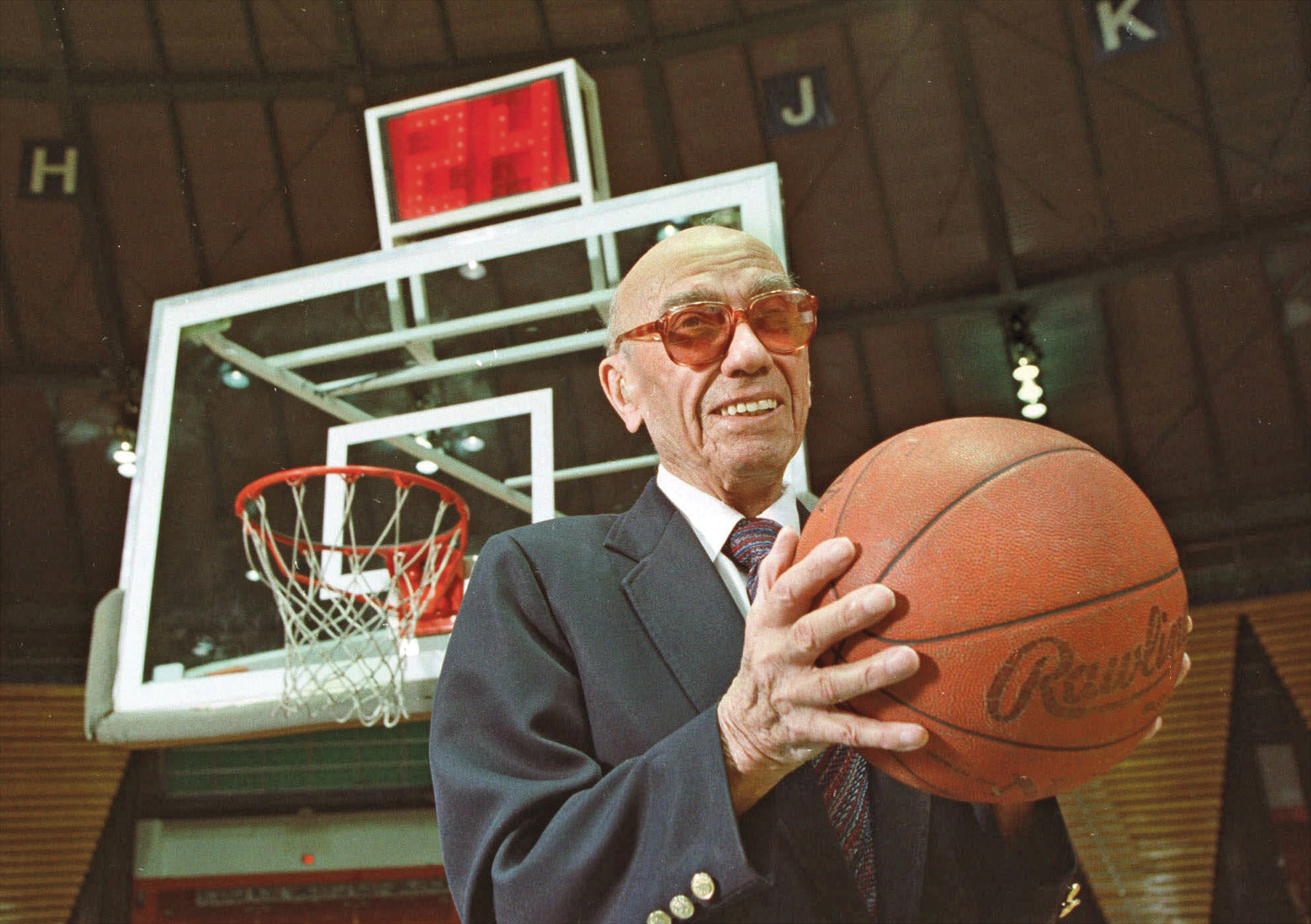
Danny Biasone’s shot clock brought new speed and excitement to basketball.
Credit: WikipediaAlthough Danny was a star quarterback at the Catholic Vocational High School, he was not offered a college scholarship, and his parents could not afford to send him without help. Danny married his high school sweetheart Rachel. They had no children. He then began working a succession of odd jobs until, at 27, he had saved enough money to open an Italian restaurant with a partner in 1936. He sold his share of the restaurant in 1941 and bought a bowling alley which made him wealthy.
Five years later, he sent a $5,000 check to the National Basketball League (NBL) headquarters in Chicago to buy a franchise. In the Fall of 1946, his Syracuse Nationals began play with Leo F. Ferris (1917-1993) as the general manager and Alfred (Al) Nicholas Cervi (1917-2009) as the coach. In 1949, the NBL was absorbed by the National Basketball Association (NBA).
The faster paced, more exciting game brought about by the shot clock drew more fans to professional basketball.
By the early 1950s, basketball was degenerating into a lackluster game of keep-away. Teams ahead in the 4th quarter would simply stall for time, passing the ball back and forth, dribbling away from opponents, while crowds moaned, booed, and headed for the exits. To prevent the game from heading into oblivion, Danny devised the 24-second shot clock by dividing the estimated number of 120 shots per game over the previous three seasons into the 2,880 seconds of a 48-minute game. The NBA adopted it as a rule starting in the Fall of 1954. Results were immediate and striking. The faster paced, more exciting, high-scoring game appealed to more fans who flocked to court sides. Danny was dubbed a savior and “The Patron Saint of the NBA” by League Commissioner, Maurice Podoloff (1890-1985). His Nationals won the NBA championship for the 1954-55 season. After the 1962-63 season, Danny sold the Nationals for a handsome profit to investors who moved the team to Philadelphia and renamed them the 76ers. Danny remained in Syracuse to run his noisy but prosperous bowling alley.
In 1982, Danny received the annual John W. Bunn Lifetime Achievement Award from the NBA. He was its tenth recipient. The award was named after Bunn who served from 1949 to 1969 as the first Chairman of the Basketball Hall of Fame Committee and was given to a person who contributed significantly to the sport. Danny died from a blood infection at the University Hospital in Syracuse on May 25, 1992, at the age of 83. He was posthumously inducted into the Naismith Memorial Basketball Hall of Fame as a contributor to the game in 2000.
March/April 2022




